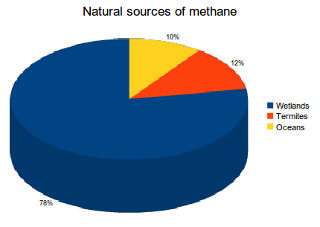Apart from being created by human activities, methane is also released into the atmosphere by natural processes. Wetlands, termites and the oceans are all natural sources of methane emissions.
The amount of methane produced by natural sources is completely offset by natural methane sinks and has been for thousands of years. Before the influence of humans, methane levels were quite steady because of this natural balance. Today, human-related sources create the majority of total methane emissions which has upset the natural balance that existed before the Industrial Revolution.
Wetlands are an important source of methane, accounting for 78% of all naturally produced emissions. Other natural methane sources include termites (12%) and the oceans (10%).
 Source: Bousquet, P. et al. (2006). Contribution of anthropogenic and natural sources to atmospheric methane variability.
Source: Bousquet, P. et al. (2006). Contribution of anthropogenic and natural sources to atmospheric methane variability.Wetlands
Wetlands are the largest natural source of methane. This produces 78% of natural methane emissions. The water-logged conditions of wetlands are perfect for microbes who require environments with no oxygen and abundant organic matter.
While part of wetland related emissions is absorbed by methane-consuming microbes, a large percentage escapes into the atmosphere. Wetlands create 147 million tonnes of methane each year.
Termites
Termites are a significant natural source of methane. During the normal digestion process of a termite, methane is produced. Termites eat cellulose but rely on micro-organisms in their gut to digest it which produces methane during the process. This is responsible for 12% of natural methane emissions.
Each termite produces very small amounts of methane on a daily basis. However, when this is multiplied by the world population of termites, their emissions add up to 23 million tonnes of methane annually.
Oceans
Another significant natural source of methane comes from the oceans. Methane producing microbes living in the ocean create these emissions. This creates 10% of natural methane emissions. Globally, oceans create 19 million tonnes of methane annually.
The majority of oceanic methane emissions gets produced in deeper sediment layers of productive coastal areas. This accounts for 75% of the oceans methane emissions. The methane created by these microbes mixes with the surrounding water and is emitted to the atmosphere from the ocean surface.
No comments:
Post a Comment